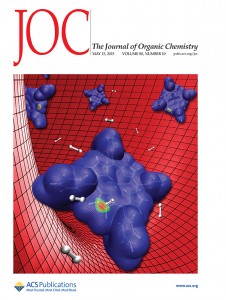The reduction of a free-base chlorin generally forms a bacteriochlorin (BC), while the reduction of the corresponding metallochlorin forms a metalloisobacteriochlorin (M-iBC). Nearly 50 years after its discovery, the regioselective reduction of chlorins was now explained: Bruhn, T.; Bückner, C. J. Org. Chem. 2015, 80, 4861–4868. (cover article 2015, 80(10))
A combination of DFT-calculated average local ionization energies (ALIEs), thermodynamics of the products, and the transition-state trajectories of reduction reactions of meso-tetraaryl- and β-octaethylchlorins, as their free bases and zinc complexes, now fully delineate the theoretical basis of the reduction regioselectivity. The reactions are kinetically controlled. Steric effects originating in the conformational flexibility of the chlorin macrocycle direct the reactions toward the formation of iBCs. Only when electronic effects are strong enough to override the steric effects are BCs formed. The practical value of this work lies in the presentation of a simple predictive method toward synthetic tetrahydroporphyrins by reduction of chlorins.
